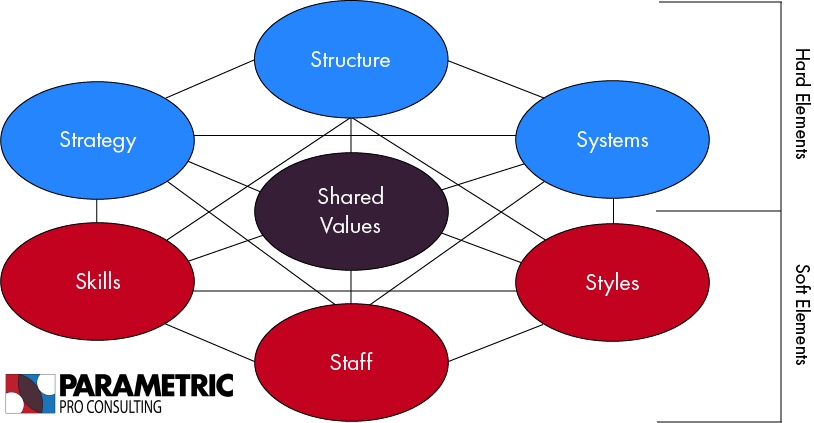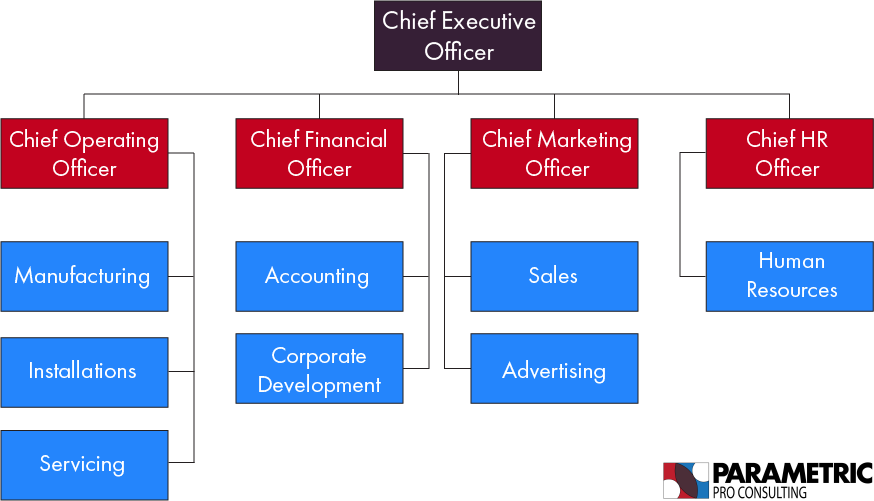Analyzing the inner workings of your company can be a highly valuable endeavor. Oftentimes, however, business owners and decision makers are unsure about how to structure their internal analysis.
McKinsey consultants, Robert H. Waterman and Tom Peters, developed the McKinsey 7-S framework in the 1980s to assist organizations who are trying to understand the current state of their organization and the state of the organization needed to achieve their superordinate goals.
As stated in the name, the model features 7-S that are interlocked. The central element of every organization is the organization’s superordinate goals, which is also referred to as the organization’s shared values. You may be prompted to simply say that the superordinate of your organization is to generate profits, but that is not the organizational goal - that is the shareholders goals.
Organizational goals could be “to provide the highest quality plumbing services in my community” or “to provide the most affordable housing possible, without compromising on quality of life”. These central goals fuel all other aspects of the organization and drive the decisions you make.
Moving outside of the central goal, there are 6 orbital features that every organization has to support its mandate: structure, strategy, systems, skills, staff, and styles (see Figure 1). The 6 orbital features are divided between “hard elements” and “soft elements”. Hard elements can be easily controlled by management and executives. Hard elements are concrete and defined. In contrast, soft elements are harder for management to explicitly control. Typically, soft elements are more influenced by company culture. There aren’t processes that can be implemented across an entire organization to correct soft elements. They are usually corrected over time and on a case-by-case basis.

The structure of an organization is straightforward. The structure is essentially the organizational chart (see Figure 2). Some important questions to ask when assessing your organization chart are the following:
Do the managers work towards a shared goal?
Are there conflicts between departments?
Is the chain of command efficient/ necessary?
Are all employees/members of the organization accountable?

Next, the systems of the organization are the backbone of the operation. This would include process flows, technologies, and procedures. Poor systems can bottleneck an organization’s productivity, so ensuring use of up-to-date technologies and efficient processes is crucial to maintain a well-run organization. Some questions to ask when assessing your organization’s systems are the following:
Is everyone aware of the systems in place?
Which systems cause bottlenecks?
Which systems can be easily improved?
Are the current systems scalable?
What type of feedback channels are there to ensure management is aware of flawed systems?
The last aspect of the soft elements in the model is strategy. An organization’s strategy is an articulated path to achieve the superordinate goals. It’s important to note that, in addition to having defined pathways to achieve their goals, successful organizations have defined sources of capital to achieve these goals. This includes every type of capital (i.e. includes financial capital, natural capital, human capital, social capital, and produced capital). An example of having a defined source of capital would be having a cash cow product line that can fuel the growth of a large potential star product line (to learn more about the different product types, check out our BCG Growth Matrix post here). Some questions to ask when assessing your organization’s strategy are the following:
Does the strategy get the organization closer to its superordinate goals?
Is the current strategy the most efficient method to achieve its superordinate goals?
Does the organization have the resources to fulfill their strategy?
Which steps need to be taken to ensure the fulfillment of the strategy?
Moving down to the hard side, skills are the abilities of the individual agents of the organization. When an organization pivots or changes their superordinate goals, it is crucial to consider if the organization, in its current state, can support the change. Some consulting practices offer change management services, where their entire mandate is to support the training and transition to a new organizational purpose. Some questions to ask when assessing your organization’s strategy are the following:
Are employees adequately trained?
Are there opportunities for employees to expand their skills?
Which new skills must be developed so the organization can achieve its superordinate goals?
Next, staff is the talent that helps the organization conduct its strategy and build the organizational culture. Culture is an often overlooked aspect of an organization. It can motivate employees to perform or it can depress employees and inspire high turnover. We’re social creatures, so building a culture that fosters our needs and wants is essential for sustainable performance. Some questions to ask when assessing your organization’s strategy are the following:
How are conflicts resolved within the organization?
How are employees encouraged to perform?
What is the company culture?
Does the company culture support the shared values of the organization and superordinate goals?
Do staff members believe in the goals of the organization?
Finally, the last section in the McKinsey 7-S model is style. Style refers to how management leads the organization. Managers can lead with fear and they can lead with encouragement. Every style fosters a different company culture. Some managers want to be every employee's friend, which can foster a lack of respect and boundaries, and others set distinct boundaries and demand respect, which can foster resentment if not handled properly. Some questions to ask when assessing your organization’s style are the following:
Which management style will foster the most ideal culture?
Do managers work within their teams or do they just delegate?
How formal is the organization?
What can you expect from your manager?
Businesses are constantly evolving organizations. They change quickly and often require agility to adapt to market forces and consumer demands. By conducting an internal organization audit, you will be able to understand where your organization is right now and where it needs to be to achieve its goals.
If you liked this post, please consider sharing it with your network!
Check out our Business Strategy Frameworks guide for more useful tools.
Want to learn more and see how we can help your business? Book a free consultation call!
Are you interested in the consulting industry? Parametric Pro Consulting Foundations offers more in-depth knowledge on this article as well as several other topics to prepare you for a career in business and consulting. Check it out here!
